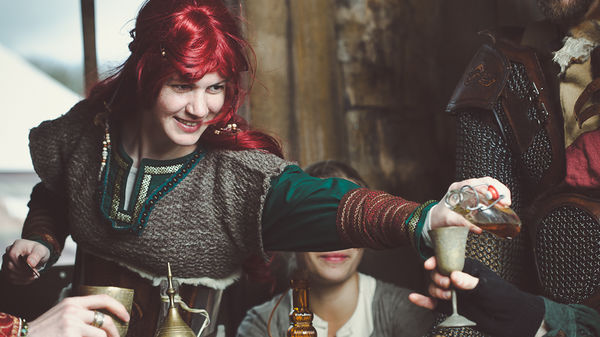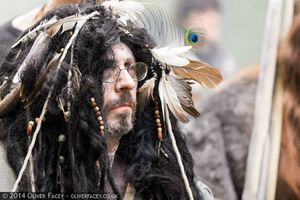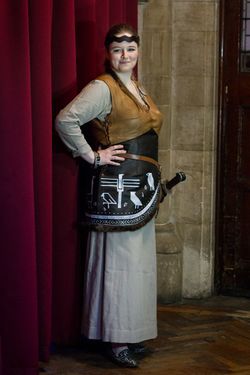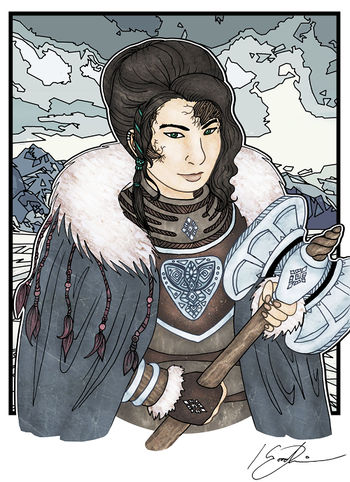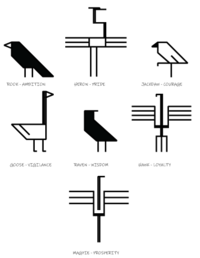Wintermark culture and customs
mNo edit summary |
mNo edit summary |
||
| (54 intermediate revisions by 6 users not shown) | |||
| Line 10: | Line 10: | ||
{{CaptionedImage|file=CM-140418-5854.jpg|align=right|width=600}} | {{CaptionedImage|file=CM-140418-5854.jpg|align=right|width=600}} | ||
When a warrior is wounded in a memorable fight, they will often encourage the [[Wintermark military concerns#Grimnir|grimnir]] to treat the wound "''so that it scars well.''" Scars are badges of honour; they serve as a visible mark of the warrior's skill and permit them to boast about the battle later - there is rarely anything to brag about a fight in which you didn't get a scar. | When a warrior is wounded in a memorable fight, they will often encourage the [[Wintermark military concerns#Grimnir|grimnir]] to treat the wound "''so that it scars well.''" Scars are badges of honour; they serve as a visible mark of the warrior's skill and permit them to boast about the battle later - there is rarely anything to brag about a fight in which you didn't get a scar. | ||
The bold, direct and uncompromising nature of the [[briar]] lineage makes them welcome among many Winterfolk, especially those of the Steinr tradition. The bark-like material that covers their wounds is treated like any other [[Wintermark Culture and Customs#Scars|scar]] and a briar with strong lineage is often given additional respect as a result. | |||
==Hospitality== | ==Hospitality== | ||
Any traveller visiting a hall in Wintermark may claim one drink, one plate of hot food and a bed by a hearth for one night, without any payment or even thanks. This generosity is mandated for one occasion only; beyond this a hall owes a traveller nothing and may turn them out into the night. However, a guest who works for their sustenance and shelter is entitled to hospitality for another night, and it is customarily unacceptable to refuse a traveller who offers to work. Wintermark folktales are filled with stories of unwanted guests who overstay their welcome which usually end when a cunning [[Suaq]] tricks them into taking unmerited food or drink, or into failing to complete their assigned work. | Any traveller visiting a hall in Wintermark may claim one drink, one plate of hot food and a bed by a hearth for one night, without any payment or even thanks. This generosity is mandated for one occasion only; beyond this a hall owes a traveller nothing and may turn them out into the night. However, a guest who works for their sustenance and shelter is entitled to hospitality for another night, and it is customarily unacceptable to refuse a traveller who offers to work. Wintermark folktales are filled with stories of unwanted guests who overstay their welcome which usually end when a cunning [[Suaq]] tricks them into taking unmerited food or drink, or into failing to complete their assigned work. | ||
Some | Some thanes choose to follow this tradition when camped with their people in the field, others refuse as tradition only demands they offer hospitality when in their hall. | ||
{{CaptionedImage|file=MysticFeathers.jpg|align=left| | {{CaptionedImage|file=MysticFeathers.jpg|align=left|caption=Feathers are wound into the hair to gain mystic insight.|width=300}} | ||
==Birds and feathers== | ==Birds and feathers== | ||
Birds are sacred to the Winterfolk, who believe that they bring a child’s soul at the moment of their birth and carry it away at the moment of death. Some wealthy Winterfolk keep birds of prey, to ensure that the heaviest and most powerful souls are brought to their children when they are born. Birds favour souls of their own nature, so a raptor usually carries the soul of a warrior or great hunter, while an owl or a raven usually brings the soul of a wise mystic or a cunning scout to be reborn. | Birds are sacred to the Winterfolk, who believe that they bring a child’s soul at the moment of their birth and carry it away at the moment of death. Some wealthy Winterfolk keep birds of prey, to ensure that the heaviest and most powerful souls are brought to their children when they are born. Birds favour souls of their own nature, so a raptor usually carries the soul of a warrior or great hunter, while an owl or a raven usually brings the soul of a wise mystic or a cunning scout to be reborn. | ||
{{CaptionedImage|file=Suaq Birds.jpg|align=right|caption=Birds are often painted on clothing by the Suaq.|width=250}} | |||
A bird’s wisdom is contained in the feathers that allow it to fly, and birds discard a feather when they are done with an idea or thought. Winterfolk of a particularly spiritual bent, especially [[Wintermark Religious Beliefs|stormcrows]] and Kallavesi mystics, often collect feathers and wear them for a lunar month. They seek to gain mystical insight by absorbing the discarded thoughts of the bird that shed the feather. Killing an animal specifically to collect its feathers is said to bring bad luck. | |||
Birds are often used as symbols of the virtues in Wintermark. The raven symbolises [[Wisdom]], the goose and the jay both symbolise [[Vigilance]], the eagle, heron and swan all symbolise [[Pride]], jackdaws often symbolise [[Courage]], magpies symbolise [[Prosperity]], hawks and falcons symbolise [[Loyalty]], and the rook symbolises [[Ambition]]. | Birds are often used as symbols of the virtues in Wintermark. The raven symbolises [[Wisdom]], the goose and the jay both symbolise [[Vigilance]], the eagle, heron and swan all symbolise [[Pride]], jackdaws often symbolise [[Courage]], magpies symbolise [[Prosperity]], hawks and falcons symbolise [[Loyalty]], and the rook symbolises [[Ambition]]. | ||
{{Anchor|Art and history}} | |||
==Scops== | |||
Scops are professional entertainers, often travellers, moving from hall to hall performing and looking for new material. Some Scops master an instrument, but many are poets; the most ambitious strive to master the high art of the Scop, the traditional Wintermark alliterative verse. Suaq and Steinr Scops traditionally give formal recitations of epic tales, favouring the stories of popular heroes. Kallavesi Scops often prefer to tell symbolic stories with complex imagery that are designed to help their listeners make auspicious decisions. | |||
Scops have an important responsibility in Wintermark, for they are the ones who grant people their [[Wintermark_hearth_magic#Names|names]]. The scops watch the younger heroes of Wintermark, those who have still to make a name for themselves. Once an individual has performed a deed of note, they give them a name, to replace their childhood name. A scop is expected to craft a name that captures a person's greatest heroic achievement, raising them up in the eyes of their peers. | |||
{{CaptionedImage|file=Scops.jpg|caption=Many of the sagas are very long and a wise scop keeps a tankard close by to refresh their voice without breaking their rhythm.|align=left|width=600}} | |||
==Riddles== | |||
Riddles are a national pastime in Wintermark, and some scops make an effort to put the best riddles into rhyming verse and preserve them. The riddling tradition originated with the [[Suaq]], who believe that creating and answering clever riddles helps a person grow more cunning, but is common in all three traditions. The Suaq like clever riddles with hidden meanings, while the Kallavesi prefer riddles whose answer reveals something about the nature of the person trying to solve them. The Steinr enjoy informal riddle-contests, where participants try to compose and answer spontaneous riddles on the spot. More formal riddle-challenges provide popular entertainment, and [[#Scops|Scops]] are often called on to judge the best riddle in a contest, looking for the hardest, the most clever, the most eloquent, or the funniest riddle | |||
The | {{CaptionedImage|file=Wintermark.jpg|align=right|width=350}} | ||
==The Good Death== | |||
The land of Wintermark is harsh but this serves to make the Winterfolk strong. It is the cold forge in which each of them is tempered. They face life unbowed by the ferocity of their land and refuse to acknowledge their own mortality. For this reason, death in their prime while striving to meet a challenge is preferable for many. Warriors seek the good death on the battlefield, but the good death is any ending that comes while pushing yourself to achieve one final act of [[heroism]]. | |||
The land of Wintermark is harsh but this serves to make the Winterfolk strong. It is the cold forge in which each of them is tempered. They face life unbowed by the ferocity of their land and refuse to acknowledge their own mortality. For this reason, death in their prime while striving to meet a challenge is preferable for many | |||
A few choose to walk north into the Heart of Ice, the great ice-storm Sydanjaa, and are never seen again. Legend says that they battle forever against the creatures deep in the storm. When someone chooses to walk into Sydanjaa they do not imagine it will achieve anything, but that it is preferable to a slow decline leading to weakness of mind and body in dotage. There is a widespread acceptance of the idea that those who challenge Sydanjaa find the good death in an attempt to unravel the mysteries and riddles of the endless storm. | A few choose to walk north into the Heart of Ice, the great ice-storm Sydanjaa, and are never seen again. Legend says that they battle forever against the creatures deep in the storm. When someone chooses to walk into Sydanjaa they do not imagine it will achieve anything, but that it is preferable to a slow decline leading to weakness of mind and body in dotage. There is a widespread acceptance of the idea that those who challenge Sydanjaa find the good death in an attempt to unravel the mysteries and riddles of the endless storm. | ||
== Funerals == | == Funerals == | ||
Heroes are interred in the Kallavesa marshes, their bones lying in the dark waters alongside those of the first king of Wintermark and the great heroes who have come since. As a hero's life fed the nation when they were alive, their body feeds the marsh in death. “''To sleep in Kallavesa''” is a powerful metaphor for the rewards of | Heroes are interred in the Kallavesa marshes, their bones lying in the dark waters alongside those of the first king of Wintermark and the great heroes who have come since. As a hero's life fed the nation when they were alive, their body feeds the marsh in death. “''To sleep in Kallavesa''” is a powerful metaphor for the rewards of heroism, and to speak of “''those who sleep in Kallavesa''” is to invoke the very heart of what it means to live in Wintermark. | ||
Wealthy Thanes usually pay for a beautifully crafted wooden boat for their body which is then sunk beneath the waters. Paupers make do with a reed raft. Kallavesi mystics are skilled at preserving bodies for the long journey to Kallavesa. | Wealthy Thanes usually pay for a beautifully crafted wooden boat for their body which is then sunk beneath the waters. Paupers make do with a reed raft. Kallavesi mystics are skilled at preserving bodies for the long journey to Kallavesa. | ||
In the past there has been conflict between the funereal mystics and the priests of the [[Necropolis]] in [[Highguard]]. The Highborn have strong traditions regarding the funerals of heroes and especially Emperors. Several times they have tried to claim that the remains of Winterfolk heroes who have done some great service for the Empire should be honoured by being interred in their cold marble crypts rather than lying in the swamp alongside their ancestors. | In the past there has been conflict between the funereal mystics and the priests of the [[Necropolis]] in [[Highguard]]. The Highborn have strong traditions regarding the funerals of heroes and especially Emperors. Several times they have tried to claim that the remains of Winterfolk heroes who have done some great service for the Empire should be honoured by being interred in their cold marble crypts rather than lying in the swamp alongside their ancestors. | ||
==Icons and Artistry== | |||
{{CaptionedImage|file=birds.png|align=right|width=200}} | |||
On the battlefield, and as decoration in their halls, Winterfolk prefer brightly colourful banners with simple, clear symbols that can be seen well from a distance. A banner is a glorious shout or a challenge to the enemies of the Winterfolk. Those who take the battlefield without a banner are sometimes treated with suspicion due to the risk that they could do something shameful without being easily identified. | |||
The Three Tears is the popular symbol for the nation of Wintermark. Usually white on a red or blue background, it references the gems set into the [[Crown of Three Tears]]. Another iconic symbol that specifically represents the unity of the three people is the Three Rings - a [http://en.wikipedia.org/wiki/Borromean_rings trio of interlocking rings woven together]. Either of these icons is likely to be decorated with additional [[Runes|runes]] but precisely which runes varies from artist to artist. | |||
Crafting is second nature to the Winterfolk. Stone, metal and wood are carved with [[runes]], but they are rarely painted, coloured or enamelled, as crafters prefer to show the beauty in the underlying colours of the materials. By contrast fabric and leather are often decorated with carefully painted or embroidered images that complement their colour and texture. | |||
There are no official or standard symbols for the Wintermark virtuous birds. Individual crafters are free to create their own sigils to reflect the virtue of a bird they are depicting. However you are welcome to use the beautiful designs created by Susan Cook which are available as [http://www.profounddecisions.co.uk/resources/downloads/birds.ai a vector file] or as [http://www.profounddecisions.co.uk/resources/downloads/birds.pdf a .pdf]. | |||
{{Wintermark Links}} | |||
[[Category:Wintermark]] | [[Category:Wintermark]] | ||
[[Category: | [[Category:Archetype]] | ||
Latest revision as of 19:04, 3 September 2025
Skein
The Winterfolk believe that each individual has a skein, a path down which that individual travels. A person's skein is not predestined at birth, rather it is fixed in places by the significant choices they make as they pass through life. The steps along the way are only the consequences of your skein; the critical moments are the points at which the individual makes a momentous choice - this is when their skein can alter. In the Winterfolk view, what happens in your life, your skein, is a direct consequence of the choices you make, the path you choose through life - the key therefore is to make the right choices.
Obviously not all the choices that a person makes are notable; what is important are the key points when far-reaching decisions are needed. At such points an individual's skein forks with the opportunity for different consequences. The Kallavesi have handed down various methods to help them identify these moments and more importantly to be able to identify what the consequences might be. Those who can accurately read a person's skein and give them advice to help them make the most auspicious choices, called mystics, are important figures in Winterfolk society.
According to the mystics, once the skein has been forked then it cannot be reversed. A person's skein can only be travelled one way; decisions cannot be undone, so it is foolish to dwell on any decision once the choice has been made. By accepting that your skein is fixed, you can commit yourself to your course and make the best of what has been decided. By travelling forwards along your skein you can hope that the future will bring opportunities to make more auspicious choices.
Scars
Scars are important to the Winterfolk. According to tradition a warrior who emerges blooded from a battle has demonstrated heroism by finding a worthy enemy to fight, and is celebrated as a consequence. As a sign of recognition, some Thanes will cut a young warrior who has fought well in their first battle but not been blooded. Others will mark a young warrior before their first battle as a way to encourage them to avoid taking unnecessary risks. Some bands re-open old wounds before a battle begins so that those who face them can mark their courage. All such cuts are little more than a nick, but done with a sharp knife so that they bleed profusely.
When a warrior is wounded in a memorable fight, they will often encourage the grimnir to treat the wound "so that it scars well." Scars are badges of honour; they serve as a visible mark of the warrior's skill and permit them to boast about the battle later - there is rarely anything to brag about a fight in which you didn't get a scar.
The bold, direct and uncompromising nature of the briar lineage makes them welcome among many Winterfolk, especially those of the Steinr tradition. The bark-like material that covers their wounds is treated like any other scar and a briar with strong lineage is often given additional respect as a result.
Hospitality
Any traveller visiting a hall in Wintermark may claim one drink, one plate of hot food and a bed by a hearth for one night, without any payment or even thanks. This generosity is mandated for one occasion only; beyond this a hall owes a traveller nothing and may turn them out into the night. However, a guest who works for their sustenance and shelter is entitled to hospitality for another night, and it is customarily unacceptable to refuse a traveller who offers to work. Wintermark folktales are filled with stories of unwanted guests who overstay their welcome which usually end when a cunning Suaq tricks them into taking unmerited food or drink, or into failing to complete their assigned work.
Some thanes choose to follow this tradition when camped with their people in the field, others refuse as tradition only demands they offer hospitality when in their hall.
Birds and feathers
Birds are sacred to the Winterfolk, who believe that they bring a child’s soul at the moment of their birth and carry it away at the moment of death. Some wealthy Winterfolk keep birds of prey, to ensure that the heaviest and most powerful souls are brought to their children when they are born. Birds favour souls of their own nature, so a raptor usually carries the soul of a warrior or great hunter, while an owl or a raven usually brings the soul of a wise mystic or a cunning scout to be reborn.
A bird’s wisdom is contained in the feathers that allow it to fly, and birds discard a feather when they are done with an idea or thought. Winterfolk of a particularly spiritual bent, especially stormcrows and Kallavesi mystics, often collect feathers and wear them for a lunar month. They seek to gain mystical insight by absorbing the discarded thoughts of the bird that shed the feather. Killing an animal specifically to collect its feathers is said to bring bad luck.
Birds are often used as symbols of the virtues in Wintermark. The raven symbolises Wisdom, the goose and the jay both symbolise Vigilance, the eagle, heron and swan all symbolise Pride, jackdaws often symbolise Courage, magpies symbolise Prosperity, hawks and falcons symbolise Loyalty, and the rook symbolises Ambition.
Scops
Scops are professional entertainers, often travellers, moving from hall to hall performing and looking for new material. Some Scops master an instrument, but many are poets; the most ambitious strive to master the high art of the Scop, the traditional Wintermark alliterative verse. Suaq and Steinr Scops traditionally give formal recitations of epic tales, favouring the stories of popular heroes. Kallavesi Scops often prefer to tell symbolic stories with complex imagery that are designed to help their listeners make auspicious decisions.
Scops have an important responsibility in Wintermark, for they are the ones who grant people their names. The scops watch the younger heroes of Wintermark, those who have still to make a name for themselves. Once an individual has performed a deed of note, they give them a name, to replace their childhood name. A scop is expected to craft a name that captures a person's greatest heroic achievement, raising them up in the eyes of their peers.
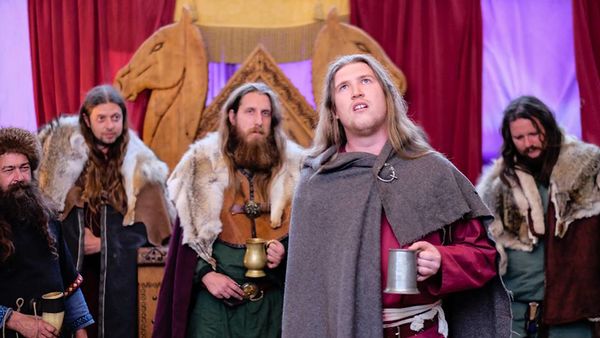
Riddles
Riddles are a national pastime in Wintermark, and some scops make an effort to put the best riddles into rhyming verse and preserve them. The riddling tradition originated with the Suaq, who believe that creating and answering clever riddles helps a person grow more cunning, but is common in all three traditions. The Suaq like clever riddles with hidden meanings, while the Kallavesi prefer riddles whose answer reveals something about the nature of the person trying to solve them. The Steinr enjoy informal riddle-contests, where participants try to compose and answer spontaneous riddles on the spot. More formal riddle-challenges provide popular entertainment, and Scops are often called on to judge the best riddle in a contest, looking for the hardest, the most clever, the most eloquent, or the funniest riddle
The Good Death
The land of Wintermark is harsh but this serves to make the Winterfolk strong. It is the cold forge in which each of them is tempered. They face life unbowed by the ferocity of their land and refuse to acknowledge their own mortality. For this reason, death in their prime while striving to meet a challenge is preferable for many. Warriors seek the good death on the battlefield, but the good death is any ending that comes while pushing yourself to achieve one final act of heroism.
A few choose to walk north into the Heart of Ice, the great ice-storm Sydanjaa, and are never seen again. Legend says that they battle forever against the creatures deep in the storm. When someone chooses to walk into Sydanjaa they do not imagine it will achieve anything, but that it is preferable to a slow decline leading to weakness of mind and body in dotage. There is a widespread acceptance of the idea that those who challenge Sydanjaa find the good death in an attempt to unravel the mysteries and riddles of the endless storm.
Funerals
Heroes are interred in the Kallavesa marshes, their bones lying in the dark waters alongside those of the first king of Wintermark and the great heroes who have come since. As a hero's life fed the nation when they were alive, their body feeds the marsh in death. “To sleep in Kallavesa” is a powerful metaphor for the rewards of heroism, and to speak of “those who sleep in Kallavesa” is to invoke the very heart of what it means to live in Wintermark.
Wealthy Thanes usually pay for a beautifully crafted wooden boat for their body which is then sunk beneath the waters. Paupers make do with a reed raft. Kallavesi mystics are skilled at preserving bodies for the long journey to Kallavesa.
In the past there has been conflict between the funereal mystics and the priests of the Necropolis in Highguard. The Highborn have strong traditions regarding the funerals of heroes and especially Emperors. Several times they have tried to claim that the remains of Winterfolk heroes who have done some great service for the Empire should be honoured by being interred in their cold marble crypts rather than lying in the swamp alongside their ancestors.
Icons and Artistry
On the battlefield, and as decoration in their halls, Winterfolk prefer brightly colourful banners with simple, clear symbols that can be seen well from a distance. A banner is a glorious shout or a challenge to the enemies of the Winterfolk. Those who take the battlefield without a banner are sometimes treated with suspicion due to the risk that they could do something shameful without being easily identified.
The Three Tears is the popular symbol for the nation of Wintermark. Usually white on a red or blue background, it references the gems set into the Crown of Three Tears. Another iconic symbol that specifically represents the unity of the three people is the Three Rings - a trio of interlocking rings woven together. Either of these icons is likely to be decorated with additional runes but precisely which runes varies from artist to artist.
Crafting is second nature to the Winterfolk. Stone, metal and wood are carved with runes, but they are rarely painted, coloured or enamelled, as crafters prefer to show the beauty in the underlying colours of the materials. By contrast fabric and leather are often decorated with carefully painted or embroidered images that complement their colour and texture.
There are no official or standard symbols for the Wintermark virtuous birds. Individual crafters are free to create their own sigils to reflect the virtue of a bird they are depicting. However you are welcome to use the beautiful designs created by Susan Cook which are available as a vector file or as a .pdf.
Further Reading
Core Brief
Further Reading
